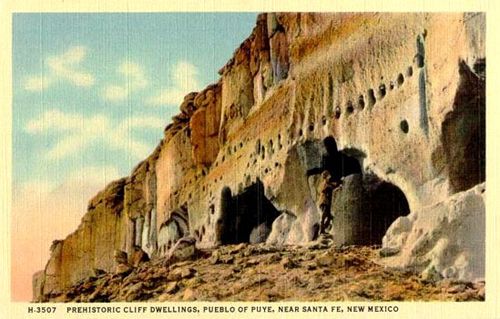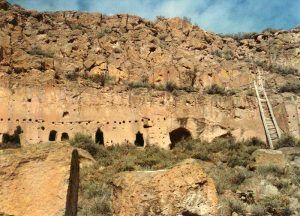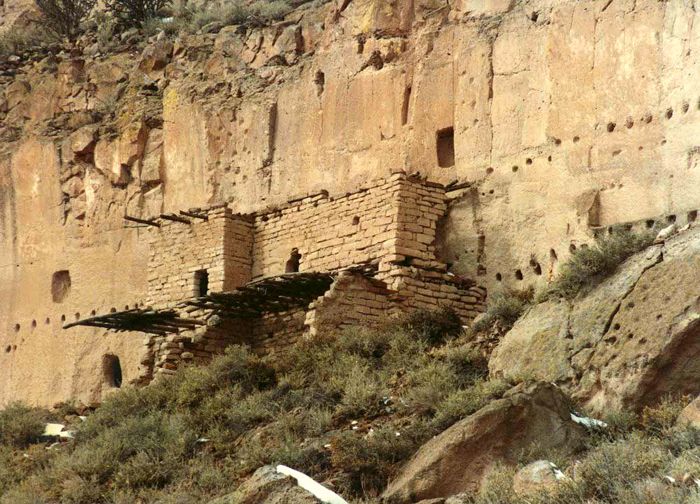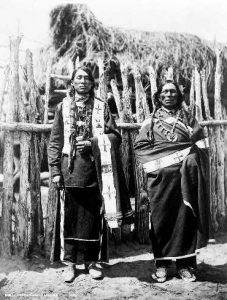
Puye Cliff Dwellings postcard.
At the Santa Clara Indian Reservation near Los Alamos, New Mexico, are the Puye Cliff Dwellings. For more than three centuries, from about 1250 to 1577 A.D., these cliff dwellings were called home to some 1,500 Pueblo Indians. Until drought forced the villagers to leave for locations nearer the Rio Grande, these ancient Indians built villages, dwelled, farmed, and hunted game here.
Through the years, it has been passed down from generation to generation that the inhabitants of the Pueblo of Santa Clara, located some ten miles east of the cliff dwelling, are the decedents of the Puye. These decedents continue to speak the Tewa language, of which the name Puye translates to “pueblo ruin where the rabbits assemble or meet.”
Carved out of a 200-foot high cliff ridge formed from the Jemez Caldera volcano that erupted more than a million years ago, the cliff dwellings contain some 740 rooms. Foundations and archeological evidence suggest that additional dwellings were constructed at the base of the cliff. The rooms dug into the cliff wall extend for over a mile along the south face of the Puye mesa, sometimes at two different levels.
Over a dozen stairways, which are more like ladders and handholds, link the great Community House on the mesa top to the rock debris at the base of a cliff and the dwellings at its side. These “stairs” leading downward in various directions have been cut and worn into the cliffs, often accompanied by finger grips to make the climbing easier.
In addition to the many dwellings, at least two underground ceremonial kivas have been found at the base of the cliffs, where large sockets were cut to hold the heavy roof beams needed to span such a large room.

Puye Cliff Dwellings, courtesy Wikipedia.
Many stairways lead up to the large “Community House,” which has been partly reconstructed on the top of the cliff. Built of blocks of volcanic tuff (rock formed from compressed volcanic ash and cinders,) the Community House may have served a defensive purpose for the ancient Indians. Portions of this structure were once up to two to three stories high.
On the many rocky faces of the walls of the cliff house, numerous petroglyphs, including animal forms, human figures, and geometric designs, can be found.
Today, the Puye Cliff Dwellings is a National Landmark, owned and operated as a cultural monument by the Pueblo of Santa Clara. The site is generally open to the public but sometimes closed for rituals.

Puye Cliff Dwellings, courtesy Wikipedia.
Two self-guided tours are available at the landmark:
The Cliff Trail begins at the Visitor Center and leads up moderately steep rails and ladders past many ancient dwellings built along and into the cliff. Prehistoric stairways link the two levels of cliff dwellings to the mesa top and its great “Community House.”
The Mesa Top Trail – Follow the graded road past the Visitor Center and continue to the parking area on the mesa top. The ground there is generally level. You can visit the 740-room pueblo ruin and its restored ceremonial chamber. The views of the Rio Grande region are spectacular. There is some space available for picnicking.
From Santa Fe, New Mexico, take I-285/84 North to the Los Alamos exit, NM 502. Follow 502, turn right on NM 30, look for a sign on the left for Puye, then follow the road for about seven miles to the cliff dwellings.
More Information:
Santa Clara Pueblo
P.O. Box 580
Espanola, New Mexico, 87532
505-753-7326
© Kathy Alexander/Legends of America, updated September 2022.
Also See:
Ancient & Modern Pueblos – Oldest Cites in the U.S.

